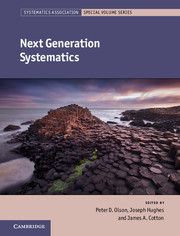Book contents
- Frontmatter
- Contents
- List of contributors
- Introduction: studying diversity in an era of ubiquitous genomics
- Part I Next Generation Phylogenetics
- Part II Next Generation Biodiversity Science
- 6 Perspective: Après le déluge: ubiquitous field barcoding should drive 21st century taxonomy
- 7 Perspective: Biodiversity and the (data) beast
- 8 Next generation biodiversity analysis
- 9 Protist systematics, ecology and next generation sequencing
- Part III Next Generation Challenges and Questions
- Index
- Systematics Association Special Volumes
- Plate section
- References
7 - Perspective: Biodiversity and the (data) beast
from Part II - Next Generation Biodiversity Science
Published online by Cambridge University Press: 05 June 2016
- Frontmatter
- Contents
- List of contributors
- Introduction: studying diversity in an era of ubiquitous genomics
- Part I Next Generation Phylogenetics
- Part II Next Generation Biodiversity Science
- 6 Perspective: Après le déluge: ubiquitous field barcoding should drive 21st century taxonomy
- 7 Perspective: Biodiversity and the (data) beast
- 8 Next generation biodiversity analysis
- 9 Protist systematics, ecology and next generation sequencing
- Part III Next Generation Challenges and Questions
- Index
- Systematics Association Special Volumes
- Plate section
- References
Summary
Introduction
The challenges faced in the analysis of high-throughput sequencing data are discussed so frequently that the issues have become palpable stereotypes. Phrases such as ‘data deluge’, ‘hockey stick graph’ and ‘bioinformatics bottleneck’ are ubiquitous to the point of spawning an internet bingo card of overused sound bytes for audiences to check off during seminars (http://bit.ly/wYNxrF). Yet for all the discussion of these challenges, the dialogue about potential solutions is ignored or wildly speculative. In the sequencing world, the game is changing and no one knows how to make the next play. Computational pipelines progress slowly compared to the pace of sequencing technology, with each new platform requiring updated iterations of code and new empirical tests of error rates and data formats.
In spite of the myriad challenges left to surmount, high-throughput sequencing has already transformed and accelerated the pace of biodiversity research. Our current bioinformatic capabilities have been hard-won: characterizing and grappling with fundamentally different sequencing chemistries and order-of-magnitude-increases in file size have required substantial initial investments. The infancy of high-throughput fields means that the current biological insights are rudimentary compared to the sophisticated, complex analyses that will become available over the next decade. Yet by simply investigating ecosystems from a new perspective (genome-scale and community-level exploration, versus the narrower genetic and taxonomic questions previously necessitated by lower throughput Sanger sequencing), we have instantly gained a transformative view of biodiversity and ecological processes. These fledgling insights are already unprecedented, and the steadily increasing breadth of computational tools continues to widen our capacity for integrative data analysis.
The birth and death of sequencing technologies
Researchers impact sequencing technology almost as much as sequencing technology drives research. The platform currently in vogue may quickly fall out of fashion when a better (and cheaper) option hits the market. Biomedical applications drive the market and design for sequencers, with many large-scale sequencing centres focusing their resources on clinical applications (BGI@UCDavis, the Broad Institute), or species of agricultural or economic importance (BGI's facilities in China). Although many ‘megasequencing’ projects focused on biodiversity are now underway (Table 7.1), more fundamental and blue-skies research questions are inherently at the mercy of the technology and protocols favoured across biomedical fields. The dominance of BGI and the falling cost of sequencing are also prompting a reshuffling of long-term visions for many core facilities.
- Type
- Chapter
- Information
- Next Generation Systematics , pp. 154 - 174Publisher: Cambridge University PressPrint publication year: 2016

